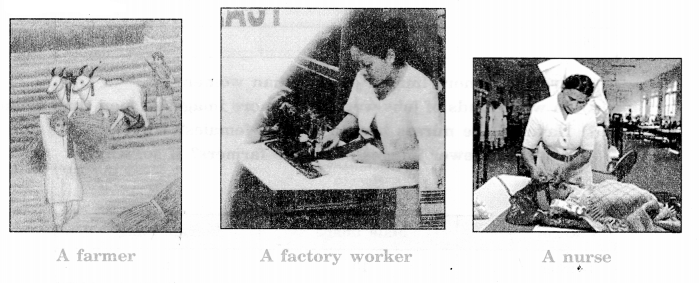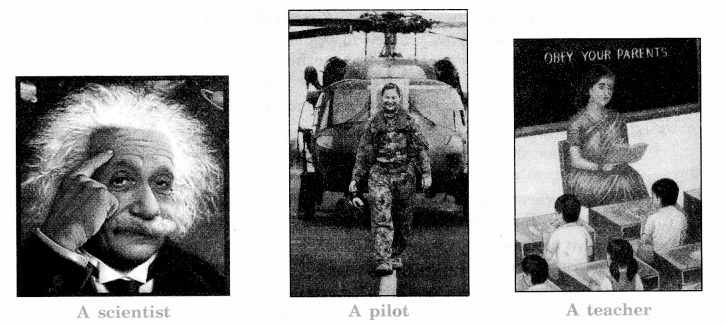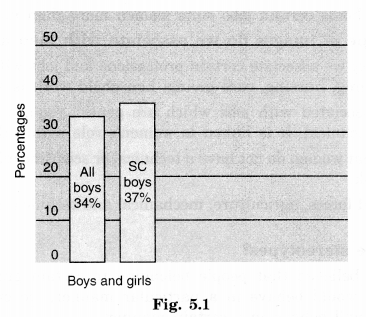NCERT Solutions for Class 7 Social Science Civics Chapter 5 Women Change the World are part of NCERT Solutions for Class 7 Social Science. Here we have given NCERT Solutions for Class 7 Social Science Civics Chapter 5 Women Change the World.
| Board | CBSE |
| Textbook | NCERT |
| Class | Class 7 |
| Subject | Social Science Civics |
| Chapter | Chapter 5 |
| Chapter Name | Women Change the World |
| Number of Questions Solved | 10 |
| Category | NCERT Solutions |
NCERT Solutions for Class 7 Social Science Civics Chapter 5 Women Change the World
NCERT TEXTBOOK EXERCISES
Question 1.
How do you think stereotypes, about what women can or cannot do, affect women’s right to equality?
Answer.
One of the stereotypes of our society about women is that they can be better nurses than army officers. The reason is that they are more patient and gentle. But women cannot be a scientist because it requires a technical mind which they don’t have. But there are women who have proved these stereotypes wrong.
For example Kiran Bedi, the first women IPS officer who has set a chain of records of successes in police service. Other examples, Kalpana Chawla, the first woman of Indian origin went into space after getting success in studying astrophysics. Thus, the above stereotypes of our society affect women’s right to equality.
Question 2.
List one reason why learning the alphabet was so important to women like Rashsundari Devi, Ramabai and Rokeya.
Answer.
Learning the alphabet was so important to women like Rashsundari Devi, Ramabai and Rokeya because of the following reason:
- Rashsundari Devi: She was not allowed to read or write.
- Ramabai: Women were not allowed to seek knowledge.
- Rokeya: Women, exposed to new ideas through English, were not thought to be correct. After learning, they were able to write about their experiences.
Question 3.
“Poor girls drop out of school because they are not interested in getting an education.” Re-read the last paragraph on page 62 (NCERT Textbook) and explain why this statement is not true.
Answer.
The statement “Poor girls drop out of school because they are not interested in getting an education” is not true because:
- There are neither proper schools nor teachers, who teach on a regular basis in rural areas.
- There are no transport facilities like buses or vans if schools are far away from people’s homes. As a result, parents are not willing to send their girls to school.
- Most of the families are too poor to bear the cost of educating all their children.
Question 4.
Can you describe two methods of struggle that the women’s movement used to raise issues? If you had to organize a struggle against stereotypes, about what women can or cannot do, what method would you employ from the ones that you have read about? Why would you choose this particular method?
Answer.
(1) The two methods of struggle that the women’s movement used are:
Campaigning: It is an important part of the women’s movement in a planned way to achieve a certain purpose or goal. For example, a women’s campaign led the Supreme Court to formulate guidelines in 1997 to protect women against sexual harassment at the workplace and within educational institutions.
Protesting: Protesting is a method of struggle of an individual or group of people against an unfavourable law or policy. For example, women protested against the violation of women’s rights of better treatment by the husband and in-laws at home.
(2) If I had to organize a struggle against stereotypes, I would employ the campaigning method.
(3) I would choose this particular method because it raises the issues and. makes aware the people concerning to the problem, positively. It leads the decision-making authority to go in-depth about the issue.
INTEXT QUESTIONS
Question 1.
Draw images of the following:
A farmer, a factory worker, a nurse, a scientist, a pilot, and a teacher. (NCERT Page 55)
Answer.


Question 2.
See what images your class drew by filling in the table below. Add up the number of male and female images separately for each occupation.
| Category | Male image | Female image |
| Teacher | ||
| Farmer | ||
| Factory worker | ||
| Nurse | ||
| Scientist | ||
| Pilot |
(i) Are there more images of men than women?
(ii) In what kinds of jobs were there more images of men than women?
(iii) Have all the nurses been drawn as females? Why?
(iv) Are there fewer images of female farmers? If so, why? (NCERT Page 55)
Answer.
| Category | Male image | Female image |
| Teacher | 10 | 40 |
| Farmer | 25 | 01 |
| Factory worker | 20 | 03 |
| Nurse | 0 | 35 |
| Scientist | 30 | 03 |
| Pilot | 10 | 01 |
- Yes, there are more images of men than women.
- In the following jobs as
- Manual work
- Military and Defence
- Office jobs
- Industries and Factories
- Farmers
- Scientists
- Pilots
- Most nurses have been drawn as females because male nurses are very few and far between. Females are generous, kind, compassionate, considerate, and enduring. Hence, they are preferred as nurses.
- Yes, because the work of a farmer is very strenuous and arduous. Women cannot do much physical work. Though there are a few females who are engaged in farming.
Question 3.
How does your class exercise compare with Rosie Ma’am’s class exercise? (NCERT Page 56)
Rosie Ma’am’s class has 30 children. She did the same exercise in her class and here is the result. (See Figure in NCERT Textbook on page 56)
| Category | Male image | Female image |
| Teacher | 5 | 25 |
| Farmer | 30 | 0 |
| Factory worker | 25 | 5 |
| Nurse | 0 | 30 |
| Scientist | 25 | 5 |
| Pilot | 27 | 3 |
Answer.
Our class exercise is comparable to that of Rosie Ma’am’s class exercise.
In both the Exercises
- Females are more in the teaching profession than males.
- Not a single woman is engaged as a farmer in Rosie Ma’am’s exercise but in our exercise, a few women are engaged as farmers.
- Very few women work in factories.
- No man works as a nurse in both exercises.
- The number of women is far less as scientists.
- Likewise, very few females are pilots.
Question 4.
Read the story and answer the questions:
- If you were Xavier, what subject would you choose and why?
- In your experience, what are some of the other pressures that boys experience? (NCERT Page 58)
Answer.
- I would have chosen history as that would help me to know about our past.
- All children especially boys feel pressure from other sources as well.
- Sometimes, these are demands from parents about taking up a subject or career options.
- Unfair teasing from the peer groups.
- Getting a good job with a high salary.
- Controlling emotions not to cry.
Question 5.
Here is a table that shows the percentage of girls and boys who leave schools from different social groups. Scheduled Caste (SC) is the official term for Dalit, and Scheduled Tribe (ST) is the official term for Adivasi.

- What percentage of children leave school at the elementary level?
- At which level of education do you see the highest percentage of children leaving?
- Why do you think that the percentage of Adivasi girls and boys leaving school is higher than that of any other group? (NCERT Page 62)
Answer.
- 52%.
- At the secondary level (63%).
- Because of the following reasons:
- Very few schools in Adivasi areas.
- No teacher in schools.
- No schools in the vicinity of their homes.
- No transport facilities for distant schools.
- The mindset of parents.
Question 6.
From the given table above, convert the figures of primary class children who leave school into a bar diagram. The first two percentages have already been converted for you in the bar diagram on the left. (NCERT Page 63)
Answer.

We hope the NCERT Solutions for Class 7 Social Science Civics Chapter 5 Women Change the World help you. If you have any query regarding NCERT Solutions for Class 7 Social Science Civics Chapter 5 Women Change the World, drop a comment below and we will get back to you at the earliest.